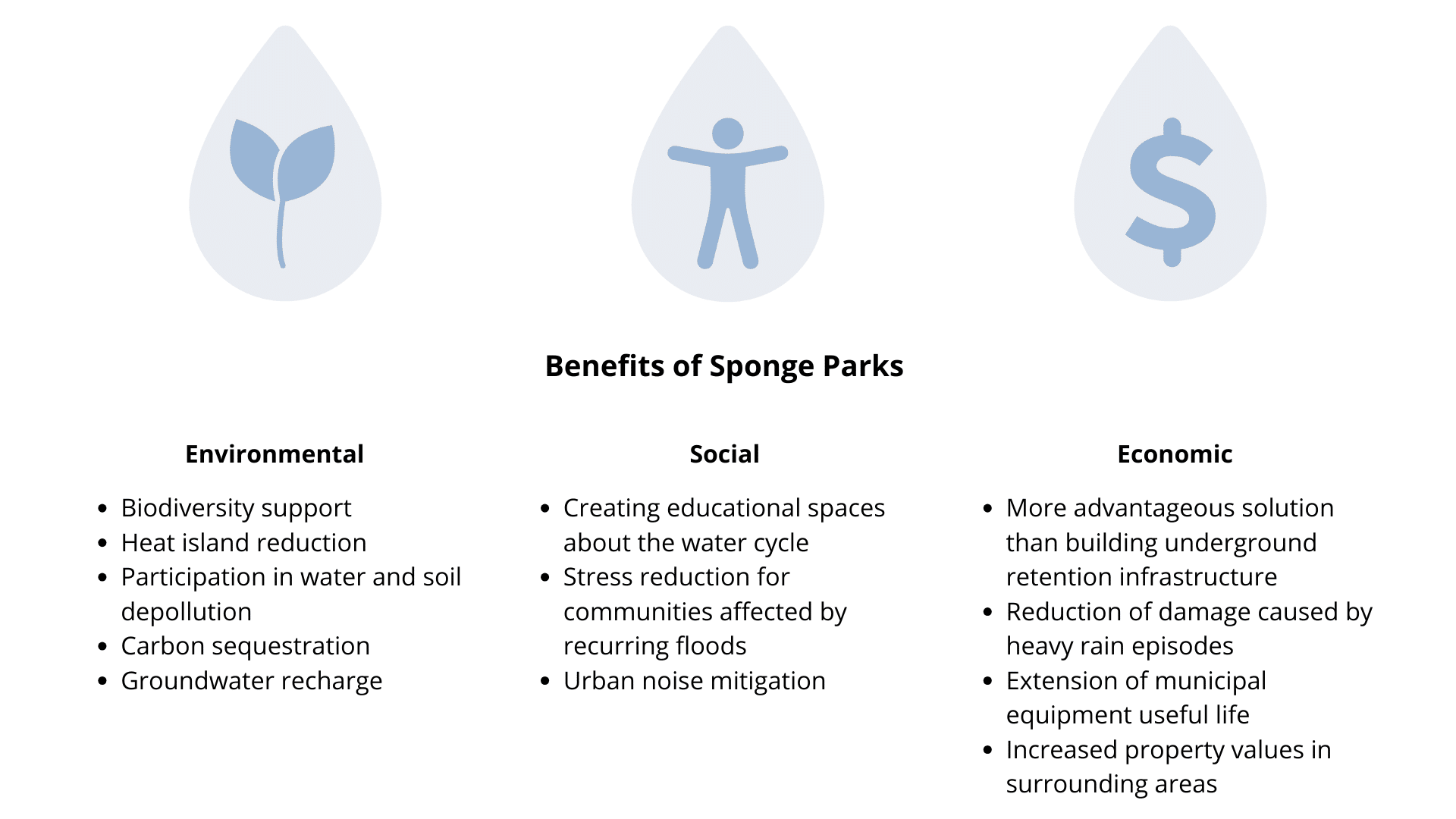- August 21, 2025
The future of public spaces? Capturing, retaining and turning heavy rainfall into an asset.
Climate challenges are increasingly visible in our cities: over recent summers, we witnessed intense precipitation resulting in recurring floods, clear signs that our infrastructure is under pressure.
Faced with these pressing realities, sponge parks embody a resilience strategy that is gaining popularity due to its multiple advantages. This green infrastructure aims to restore natural water cycles by prioritizing retention, absorption and infiltration, rather than rapid evacuation of precipitation to already overloaded storm sewers.
The key is implementing them where they will be most useful, to better integrate them into a comprehensive climate adaptation strategy.
Creating New Parks Supporting Stormwater Management
What is the difference between a traditional park, where we can expect green surfaces to have some absorption capacity, and a sponge park? The latter are green spaces that, in addition to meeting the community’s recreational needs, are specifically designed to capture, absorb and especially temporarily retain rainwater. They thus relieve the stormwater sewer network by avoiding sudden system overload, which can for example prevent costly backflows in neighboring buildings.
Water retention employs various strategies, such as integrating surface or underground retention basins, with water guided by drainage channels. Topped with walkways, these features help make the water cycle visible, fostering environmental awareness among people who use and engage with these amenities.
A sponge park isn’t just an ecological alternative to storm sewers: this re-naturing of public spaces creates welcoming community spaces where people benefit from cooling effects and integrated areas for play, rest and gathering. Better yet, while collected water might first serve to irrigate the site’s vegetation, it can also feed water features or fountains in a circular system.
In short, inserting a sponge park in an industrial or otherwise densely mineralized environment offers the opportunity to requalify and green vast mineralized and impermeable areas, whose environmental footprint can be considerable. But existing parks can also be reimagined to better participate in municipal climate resilience projects.
Reinventing Our Existing Parks
Our cities’ aging parks indeed hold strong redevelopment potential. Their transformation into sponge parks offers an opportunity to completely reinvent them. This approach achieves multiple goals: modernizing municipal equipment, improving stormwater management, increasing greening and biodiversity, and creating spaces for community reconnection with nature.
In this case, integrating absorption strategies is not limited to digging a basin intended to accommodate surplus rain at the park’s center. It involves comprehensive thinking about water pathways, plantings, surface materials and even urban furniture. Pathways can for example participate in directing water toward capture zones, while plants selected for planting will notably be chosen for their ability to withstand both heavy rain and gradual soil drying. Beyond their functional role in water management, these plants stabilize soils, promote infiltration and create refreshing microclimates. They also contribute to depollution through phytoremediation, a process by which plants absorb contaminants contained in water or soils and participate in restoring territorial health.

A sponge park’s effectiveness is measured not only by its retention capacity, but also by its relevance in the urban system where it is inserted. This is why each project must rely on analysis based on precipitation diagnosis as well as existing stormwater network, overflow risks, and other characteristics of the implementation territory. This allows the determination of the green infrastructure which will best capture and utilize abundant precipitation: beyond sponge parks, we might consider green roofs and living walls, permeable surfaces for urban spaces, landscape retention basins…
Generating long-term success relies on a transdisciplinary approach that will mobilize expertise from landscape architecture, civil engineering, sustainable strategies and urban planning to develop adapted solutions.
Toward Cities That Breathe with Water
Sponge parks represent much more than a technical solution to stormwater management challenges. They embody a new urban philosophy where infrastructure becomes landscape to better participate in an entire community’s quality of life.
In such a context where natural cycles are restored and pacified, water becomes visible, comprehensible and even desirable in our urban environments.
To learn more about how landscape architecture participates in shaping our communities’ future, see our article on Sustainable urban environments: Revisiting our cities.